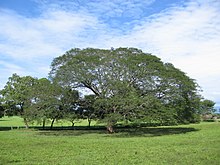Enterolobium cyclocarpum
| Enterolobium cyclocarpum | |
|---|---|
 |
|
| Specimen in Guanacaste (Costa Rica) | |
| Scientific classification | |
| Kingdom: | Plantae |
| (unranked): | Angiosperms |
| (unranked): | Eudicots |
| (unranked): | Rosids |
| Order: | Fabales |
| Family: | Fabaceae |
| Genus: | Enterolobium |
| Species: | E. cyclocarpum |
| Binomial name | |
|
Enterolobium cyclocarpum (Jacq.) Griseb. |
|
| Synonyms | |
|
Several, see text |
|
Several, see text
Enterolobium cyclocarpum, commonly known as guanacaste, caro caro, or elephant-ear tree, is a species of flowering tree in the pea family, Fabaceae, that is native to tropical regions of the Americas, from central Mexico south to northern Brazil (Roraima) and Venezuela. It is known for its large proportions, its expansive, often spherical crown, and its curiously shaped seedpods. The abundance of this tree, especially in Guanacaste Province, Costa Rica, where it is prized for the shady relief it provides from the intense sun, coupled with its immensity, have made it a widely recognized species. It is the national tree of Costa Rica.
In North America it is often called elephant-ear tree, due to the shape of the seedpods. Other common names include Devil's ear and earpod tree, parota and orejón (Spanish) or huanacaxtle (Nahuatl). In El Salvador, it is known as conacaste.
The guanacaste is a medium-sized to large tree, growing to 25–35 m tall, with a trunk up to 3.5 m in diameter. Unusual in a tree of these proportions, buttresses are completely lacking. The bark is light gray, with prominent dark reddish-brown vertical fissures. In young trees these fissures are closer together. and their confluence lends a characteristic reddish hue to the bark of guanacaste saplings. Older specimens often present broken, chipped or scarred bark.
The crown is broad and widely spreading. The height at which branches first occur along the trunk – as well as the overall tree shape – vary considerably among individuals and are habitat-dependent characteristics. Frequently, guanacaste trees grow as single specimens in a sunny pasture. Under these conditions, massive, extended, horizontal limbs emerge low on the boles, forming giant, hemispherical, widely spreading crowns. In the forest (where competition for light is intense) trees tend to become taller, and branching occurs at a higher level. Tree forms then become somewhat narrower, though crowns are still rounded, and hemispherical shapes are maintained by those that have reached the canopy.
...
Wikipedia
